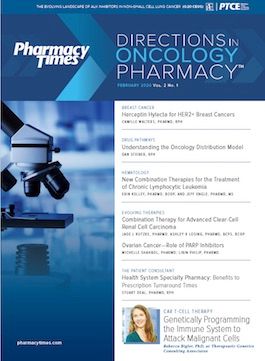Publication
Article
Pharmacy Practice in Focus: Oncology
Herceptin Hylecta for HER2-Positive Breast Cancer
Author(s):
Key Takeaways
- Trastuzumab and hyaluronidase-oysk is approved for subcutaneous use in HER2-positive breast cancer, offering a convenient alternative to intravenous administration.
- The HannaH and SafeHER trials demonstrated pharmacokinetic and clinical noninferiority of the subcutaneous formulation compared to intravenous trastuzumab.
HER2 is a membrane-bound tyrosine kinase that when amplified contributes significantly to a tumor’s ability to proliferate and survive.
ON FEBRUARY 28, 2019, the FDA granted Genentech approval of trastuzumab and hyaluronidaseoysk (Herceptin Hylecta) for subcutaneous (SC) injection. In patients with HER2-overexpressing breast cancer, trastuzumab and hyaluronidase-oysk may be used in the adjuvant and metastatic settings.1
Mechanism of Action
HER2 is a membrane-bound tyrosine kinase that when amplified contributes significantly to a tumor’s ability to proliferate and survive. Trastuzumab has been shown to mediate targeted antibody-dependent cellular cytotoxicity in tumor cells with HER2 overexpression.2
Normally, the required volume of trastuzumab is too large to be absorbed through the subcutaneous matrix. Hyaluronidase, however, aids in absorption by depolymerizing the hyaluronan found in the SC tissue. The effect is transient, lasting 24 to 48 hours.2
Dosing and Administration
The treatment is available as a 600-mg trastuzumab/10,000-unit hyaluronidase per 5-mL solution for injection. It is approved as a flat 600-mg/10,000-unit dose for patients with HER2-positive cancer in the adjuvant and metastatic settings, in combination with or following traditional chemotherapy. Unlike the intravenous (IV) formulation, no loading dose or weight-based dose adjustment is required.2
A single 5-mL injection is administered under the skin, alternating between the right and left thighs, over 2 to 5 minutes every 3 weeks.2
Clinical Studies
The safety and efficacy of intravenous trastuzumab have been previously studied and confirmed in multiple clinical trials. The trastuzumab and hyaluronidase-oysk combination was approved based on the results of the HannaH (NCT00950300) and SafeHER (NCT01566721) trials.1
The HannaH study compared trastuzumab in its IV and SC forms. HannaH was a randomized, openlabel, multicenter trial that included 596 patients with HER2-overexpressing (as determined by immunohistochemistry 3+ or fluorescence in situ hybridization positivity) operable or locally advanced breast cancer. Patients received 8 cycles of chemotherapy in combination with IV or SC trastuzumab, followed by surgery and an additional 10 cycles of trastuzumab monotherapy to complete 18 cycles. Primary end points included serum trough levels before cycle 8 and pathologic complete response (pCR) at the time of surgery. The geometric mean ratio of serum trough concentration SC to IV was 1.33 (90% CI, 1.24-1.44), and the difference in pCR was 4.7% (95% CI, —4.0% to 13.4%), thus confirming pharmacokinetic and clinical noninferiority of trastuzumab and hyaluronidase- oysk.2,3
The SafeHER trial was designed to assess the safety and tolerability of trastuzumab and hyaluronidaseoysk. It was a prospective, open-label study enrolling 2573 adults with clinical stage I to III HER2-positive breast cancer. Patients received trastuzumab 600 mg administered subcutaneously every 3 weeks for 1 year, with concurrent or sequential chemotherapy. Chemotherapy regimens were given per provider discretion. Rates of adverse events were higher in the concurrent chemotherapy groups but raised no new safety concerns compared with the safety profile of traditional IV trastuzumab.2,4
Warnings and Precautions
As with the IV formulation, trastuzumab and hyaluronidase-oysk can cause cardiac abnormalities, including but not limited to cardiomyopathy, left ventricular dysfunction, hypertension, and death. These risks are increased when the combination is administered with other cardiotoxic medications, such as anthracyclines. Cardiac function assessment, including left ventricular ejection fraction (LVEF) measurement, is recommended prior to initiation and every 3 months during and upon completion of therapy. Trastuzumab and hyaluronidase-oysk should be held for absolute LVEF decrease of ≥16% or when values fall below institutional limits of normal with a 10% decrease from baseline. Rates of cardiomyopathy were similar between the IV and SC formulations.2
In clinical trials, administration-related reactions occurred in approximately 13% of patients administered trastuzumab and hyaluronidase-oysk. Patients experiencing low-grade (grade 1 or 2) hypersensitivity reactions may be rechallenged with the addition of analgesic, antipyretic, or antihistamine premedication. Severe or anaphylactic reactions should result in permanent discontinuation of any trastuzumab product.2
Trastuzumab and hyaluronidase-oysk also carries boxed warnings for serious and fatal pulmonary toxicity and embryo-fetal toxicity. Patients should be appropriately screened for preexisting pulmonary deficiencies and pregnancy status before beginning therapy.2
Adverse Events
Other common adverse events reported in clinical trials included alopecia, rash, nausea, diarrhea, vomiting, fatigue, edema, neutropenia, arthralgia, myalgia, injection site reaction, upper respiratory tract infection, and cough. The incidence of these events was similar between the SC and IV formulations.2,4
CAMILLE WALTERS, PHARMD, RPH, PHARMD, is a graduate of Creighton University School of Pharmacy and Health Professions. She currently practices as a hematology/medical oncology pharmacist at the Mayo Clinic in Rochester, Minnesota.
REFERENCES
- FDA approves new formulation of Herceptin for subcutaneous use [press release]. FDA website. March 18, 2019. fda.gov/drugs/drug-approvals-and-databases/fda-approves- new-formulation-herceptin-subcutaneous-use. Accessed October 23, 2019.
- Trastuzumab and hyaluronidase-oysk (Herceptin Hylecta) [package insert]. South San Francisco, CA: Genetech, Inc.; 2019. gene.com/download/pdf/herceptin_hylecta_ prescribing.pdf
- Jackisch C, Hegg R, Stroyakovskiy D, et al. HannaH phase III randomised study: Association of total pathological complete response with event-free survival in HER2-positive early breast cancer treated with neoadjuvant—adjuvant trastuzumab after 2 years of treatment-free follow-up. European Journal of Cancer. 2016;62:62-75.
- Gligorov, J., Ataseven, B. and Verrill, M. (2017). Safety and tolerability of subcutaneous trastuzumab for the adjuvant treatment of human epidermal growth factor receptor 2-positive early breast cancer: SafeHer phase III study's primary analysis of 2573 patients. European Journal of Cancer. 2017; 82:.237-246.

Newsletter
Stay informed on drug updates, treatment guidelines, and pharmacy practice trends—subscribe to Pharmacy Times for weekly clinical insights.





